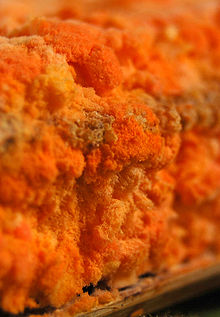- Oncom
-
Oncom pronounced /ɒnˈtʃɒm/ is one of the traditional staple foods of West Javan (Sundanese) cuisine. There are two kinds of oncom: red oncom and black oncom. Oncom is closely related to tempeh; both are foods fermented using mold.[1]
Usually oncom is made from the by-products from the production of other foods -- soy bean tailings (okara) left from making tofu, peanut presscake left after the oil has been pressed out, cassava tailings when extracting the starch (pati singkong), coconut presscake remaining after oil has been pressed out or when coconut milk has been produced.
Since oncom production uses by-products to make food, it increases the economic efficiency of food production.
Red oncom reduces the cholesterol levels of rats,[2] suggesting effects in humans.
Black oncom is made by using Rhizopus oligosporus while red oncom is made by using Neurospora intermedia var. oncomensis.[3] It is the only human food produced from Neurospora.
Toxicity
In the production of oncom, sanitation and hygiene are important to avoid contaminating the culture with bacteria or other fungi like Aspergillus flavus (which produces aflatoxin). Neurospora intermedia var. oncomensis and Rhizopus oligosporus reduce the aflatoxin produced by Aspergillus flavus.[4] However, aflatoxin-producing molds (Aspergillus spp.) are often naturally present on peanut presscake. Furthermore coconut presscake can harbor the very dangerous Pseudomonas cocovenenans, which produces two highly toxic compounds - bongkrek acid and toxoflavin. Shurtleff and Aoyagi address toxicity in their book section on oncom.
While it is known that soybeans are the best substrate for growing R. oligosporus to produce tempeh, oncom has not been as thoroughly studied; the best fermentation substrates for producing oncom are not yet known.
Reference
- ^ "Production of High-Quality Oncom, a Traditional Indonesian Fermented Food, by the Inoculation with Selected Mold Strains in the Form of Pure Culture and Solid Inoculum", D. D. Sastraatmadja et al., J. Grad. Sch. Agr. Hokkaido Univ., Vol. 70, Pt. 2: 111-127 (2002), at [1]
- ^ 'Plasma cholesterol reduction by defatted soy ontjom (fermented with Neurospora intermedia) in rats fed a cholesterol-free diet.'
- ^ Ho C.C. 1986. Identity and characteristics of Neurospora intermedia responsible for oncom fermentation in Indonesia. Food Microbiology 3(2):115-132 (April 1986).
- ^ 'Effect of Rhizopus and Neurospora spp. on growth of Aspergillus flavus and A. parasitus and accumulation of aflatoxin B1 in groundnut'
Indonesian cuisine by ethnic group Common Indonesian dishes - Nasi goreng
- Nasi campur
- Nasi kuning
- Sate
- Soto
- Semur
- Tempeh
- Tahu goreng
- Gado-gado
- Sambal
- Acar
- Ketupat
- Lontong
- Bubur ayam
- Rujak
- Otak-otak
- Emping
- Krupuk
- Rijsttafel
Sasak - Ayam Taliwang
- Plecing kangkung
- Beberuk terong
Balinese - Betutu
- Lawar
- Babi guling
Javanese - Botok
- Buntil
- Gudeg
- Mie rebus
- Nasi bogana
- Nasi kucing
- Nasi liwet
- Nasi pecel
- Opor Ayam
- Pecel
- Rawon
- Sayur lodeh
- Serundeng
- Tumpeng
- Tongseng
Sundanese - Lalab
- Karedok
- Pepes
- Sayur Asem
- Oncom
- Soto Bandung
- Empal gentong
- Siomay
- Batagor
- Serabi
- Laksa
- Asinan Bogor
- Kupat tahu
- Tahu sumedang
Betawi - Nasi uduk
- Nasi ulam
- Nasi kebuli
- Ketoprak
- Soto Betawi
- Kerak telor
- Asinan Betawi
Minangkabau Sumatran Malay Batak - Saksang
- Arsik
- Babi panggang
Manado - Tinutuan
- Paniki
- Cakalang fufu
Makassar and Bugis - Coto Makassar
- Pallubasa
- Konro
- Sop sodara
- Kapurung
- Burasa
Maluku and Papuan - Papeda
- Sagu
- Babi bakar
Chinese Indonesian - Nasi Tim
- Bakmi
- Bakso
- Cap cai
- Fu yung hai
- Lumpia
- Mie goreng
- Mie Kering
- Swikee
Snacks - Pisang goreng
- Lupis
- Klepon
- Kolak
- Rempeyek
- Lapis legit
- Onde-onde
- Bika Ambon
Beverages See also: List of Indonesian dishes Soy General Soy allergy · Soy candle · Soy ink · Soy molasses · Soy paint · Soy protein · Soybean · Soybean diseases · Soybean meal · Soybean oil

Soy based dishes Aburaage · Agedashi tofu · Bai ye · Douhua · Dubu kimchi · Edamame · Hiyayakko · Kongguksu · Kongnamul · Mapo doufu · Miso soup · Sundubu jjigae · Tahu goreng · Tofu skin roll · Yong Tau Foo
Milk substitute Meat analogues Sauces and condiments Dajiang · Doenjang · Doubanjiang · Douchi · Kinema · Miso · Nattō · Soy sauce · Teriyaki · Tauco · Tian mian jiang · Tương · Yellow soybean paste
Various other foods Mamenori · Okara · Oncom · Soy flour · Soy milk based infant formula · Stinky tofu · Tofu skin
Companies 8th Continent · Alpro · Boca Burger · Gardenburger · Morningstar Farms · Silk · So Good · Tofutti · Turtle Mountain · Vitasoy · Yeo Hiap Seng
Categories:- Fermented foods
- Soy products
- Vegetarian cuisine
- Sundanese cuisine
- Food stubs
Wikimedia Foundation. 2010.


